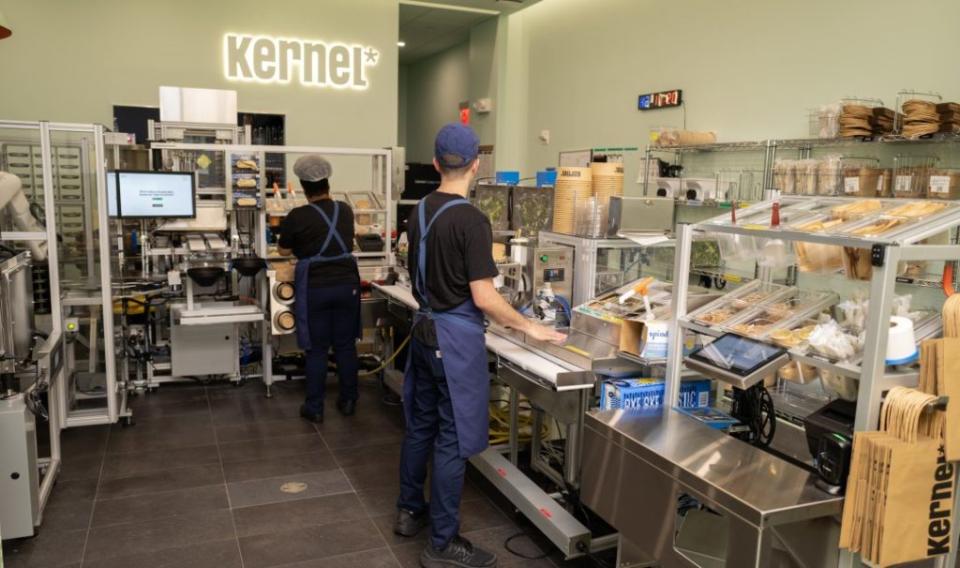These fast-food workers are earning $25 an hour with paid vacation—as long as they work alongside a giant burger-slinging robot arm
The staff at Kernel, a vegan takeout joint in Manhattan, have it better than many fast-food workers. They make a starting wage of $25 per hour and have paid days off and sick leave. They are slated to become employee-owners in a stock-option plan in the works.
But there is a catch to the perks of the job. Like most other workplaces, Kernel employees have a quirky, larger-than-life coworker: a six-axis robot arm that can reach over 3 feet and lift over 11 pounds at the wrist. Its nickname is “El Capitan.”
The arm, created by the German manufacturer Kuka, is the focal point of the store. As orders come in online, the Kuka robot plucks food items off a holding tray, places them in an oven, and passes them onto its human coworker on the assembly line. Its carefully calibrated movements help Kernel—which serves a small menu of plant-based sandwiches and sides—literally run like a well-oiled machine.
Kernel’s human workers don’t seem to mind the robot stealing the spotlight. The store has a 100% employee retention rate, a rarity in the industry—though it only has three staff members in the store at a given time and has been open about a month. Chipotle founder Steve Ells launched Kernel with $36 million in backing.
“Team members are enjoying the experience and automation is creating a better working environment for them and not a worse one,” Stephen Goldstein, Kernel’s president, told Fortune.
The revolution will be roboticized
Kernel is on the cutting edge of the robot-retail movement, a growing trend of stores and fast-food restaurants increasingly relying on automated technologies and customer-interfacing bots. Retail has been incorporating automation into its systems for years now—think Domino’s mesmerizing Pizza Tracker introduced in 2008—but introducing physical, large-scale robots into retail spaces is relatively new.
“To some extent, the restaurant industry is a microcosm,” Bank of America analyst Sara Senatore told Fortune. “Software has become pretty pervasive: relying on computers to predict things, to plan things, to certainly aggregate and quantify and analyze data. But the bigger challenge, then, is actually integrating them or incorporating them from a physical process.”
All of this technology—from online ordering to robots making food—streamlines service and increases volume and sales.
For fast-casual restaurants, investments in automation are coming to fruition: Sweetgreen implemented the Infinite Kitchen, an automation service that assembles salads and bowls, in its first store last spring and opened a second location with the technology in December. In its fourth-quarter earnings report, Sweetgreen—which has struggled for years with profitability—reported the two suburban locations with Infinite Kitchen have 10% higher tickets on average than those of surrounding markets.
“The Infinite Kitchen continues to deliver many benefits to our operating model, such as higher throughput, better order accuracy, portioning consistency and substantially lower team member turnover,” CFO Mitch Reback said in the earnings call.
Development and installation for Infinity Kitchen is expensive—about half a million dollars—but Sweetgreen expects to see a seven-point benefit to margins for restaurants with the system.
Leaning into automation isn’t always successful. Robot-powered grain-bowl restaurant Eatsa shuttered both of its New York locations in 2017, admitting it expanded its concept too fast without nailing down a menu.

Human-robot harmony
The expansion of automation in restaurants is growing in part because of savings on labor costs, which make up about 36% of an average restaurant’s costs, according to a BofA note by Senatore. These changes don’t mean robots are coming for workers’ jobs—it’s actually the opposite.
“It's more of a reallocation of labor or hours towards more value added,” Senatore said. “In many cases, this reallocation benefits the customers, but it also benefits the employee.”
In the restaurant industry, where turnover rates are high and costly to companies, keeping employees happy is crucial. According to the Bureau of Labor Statistics, the food and accommodations sector has a 5.1% quit rate. A 2022 McKinsey & Company report found quit rates in retail are 70% higher than in other sectors.
At Kernel, the Kuka robot, as well as its other automated systems, have helped make employees more efficient and increase their agency on the job, Goldstein said.
One employee talked with the software engineering team about re-coding the Kuka arm to remove a burger patty from the oven at the same time as its bun finished toasting. Another tweak changed the order of the ingredients on the assembly line to minimize workers bending over and straining their backs.
“This is the first restaurant job I’ve had that doesn’t leave me broken or beaten at the end of the day,” Kernel staff member Carlos De La Concha told Fortune over email.
Fewer instances of human-error-related food waste helps the restaurant keep prices lower—$7 for a veggie burger, compared to Shake Shack’s $8.29 for the Veggie Shack.
Kernel did not provide Fortune with any sales data, but Goldstein said the restaurant has plans to scale and open 10 restaurants, give or take, over the next two years.
But growing a restaurant concept that is new and still developing will have its hiccups. Senatore warns scaling and adapting automated technologies in restaurant spaces will be the biggest challenge in the model’s success. In the broader industry, restaurants trying to retrofit new technology in their space and culture will have difficulty figuring out how to best outsource tasks to automation and create a synergetic relationship between technology and employees. Kernel may have its robotic features at the core of its business, but Goldstein still expects to have to make some tweaks, just like any growth would require.
“It's going to be the business model adaptation and how we think about, What do you want to serve customers? How do you want to change the menu? So how does this look differently?” he said.
This story was originally featured on Fortune.com
